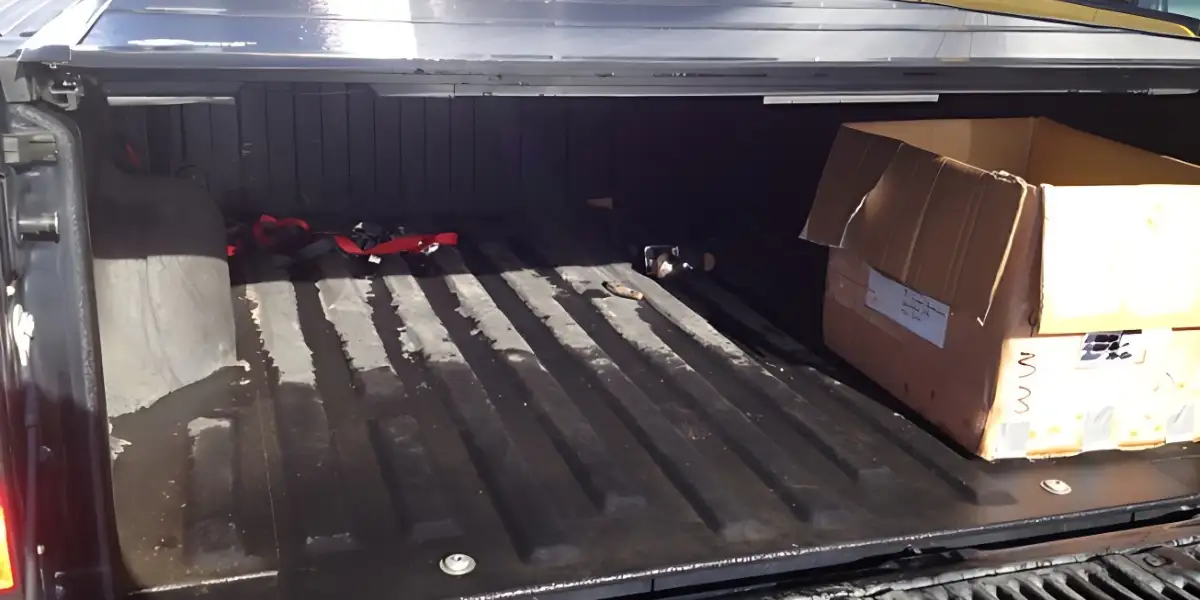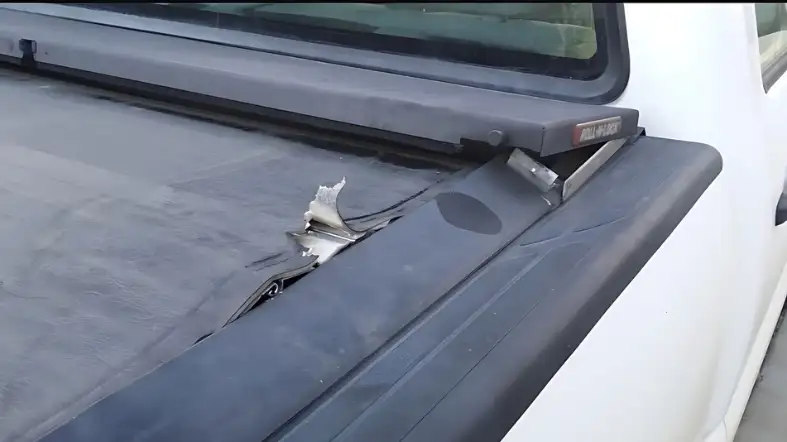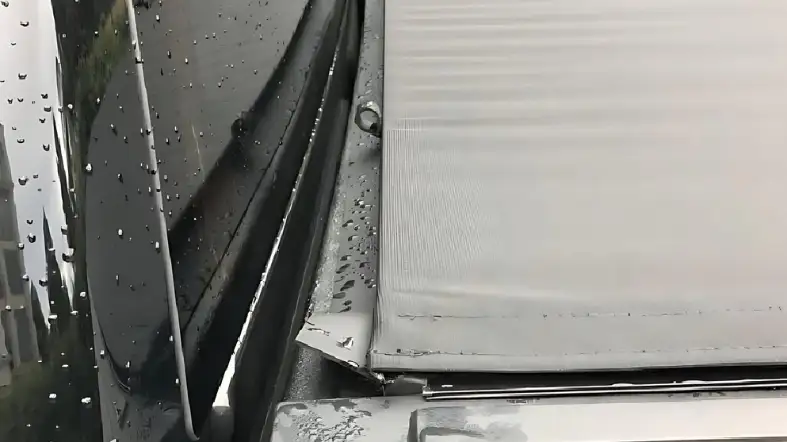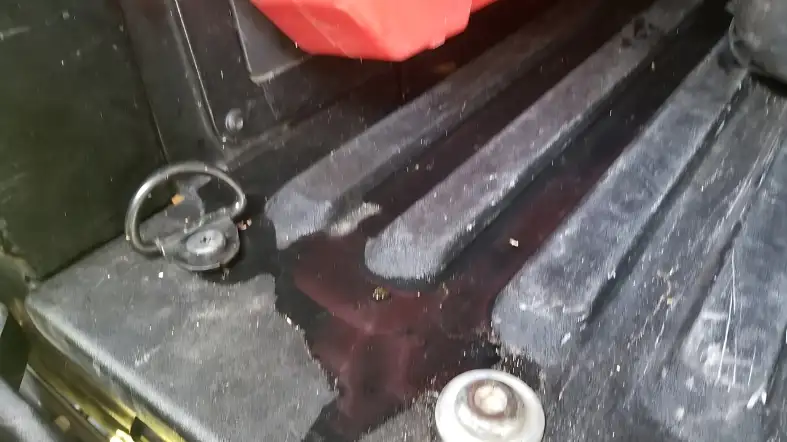Is your tonneau cover leaking at the tailgate? Discover the possible causes and effective solutions in this article.
Leaks can result from damaged seals, misaligned tailgates, or incorrect installation.
By following our step-by-step process, you can identify the source of the leak and fix it.
We also provide tips to prevent future leaks, such as proper cleaning, tension adjustment, and regular maintenance.

Tonneau Cover Leaking At Tailgate
There are a few reasons your tonneau cover might leak at the tailgate.
The seal may be damaged or worn, the tailgate must be properly aligned, or the tonneau cover could be installed incorrectly.
To fix a leak, clean the area, apply sealant, replace the seal, adjust the tailgate, or reinstall the cover.
18 Ways To Identify The Leak In A Tonneau Cover Tailgate
Open Tailgate with Cover Closed
To begin, open the tailgate while keeping the tonneau cover closed. This way, you can simulate rain by pouring water over the cover.
Observe where the water drains off to identify the specific area of the leak.
Inspect for Visible Holes
Open the tailgate and visually inspect the tonneau cover for any holes or gaps that could potentially allow water to enter.
You can do this by using a flashlight to examine the cover from the truck bed or by inspecting it from the exterior.
Conduct a Water Hose Test
Close the tonneau cover and leave the tailgate open.
Ask someone to assist you by spraying water from a hose over the cover while you observe any water entering the truck bed.
This test can help you pinpoint the location of the leak.
Inspect Seals and Gaskets
Check the seals and gaskets around the tonneau cover, paying particular attention to the edges and corners.
Look for signs of wear, damage, or gaps that may allow water to seep through.
Insulation Inspection
Examine the insulation around the tonneau cover, such as water pipe insulation.
Look for any areas where the insulation may have deteriorated or become detached, as this can cause leaks.
Test During Heavy Rain
Park your vehicle outside during heavy rainfall and observe whether water enters the truck bed.
This can help determine if the tonneau cover effectively seals against water penetration.
Check for Water Stains
After rain or car washes, check for water stains or dampness inside the truck bed. These indications can help you identify the presence of leaks in the tonneau cover.
Inspect the Drainage System
Examine the drainage system of the tonneau cover, including drain tubes or channels.
Make sure they are clear of debris or blockages that may hinder proper water flow.
Check for Loose or Damaged Components

Inspect the tonneau cover for any loose or damaged components, such as hinges, latches, or fasteners.
These issues can contribute to leaks if the components are not functioning properly.
Look for Water Accumulation
Check the truck bed for pooled water after rain or washing the vehicle. The presence of pooled water can indicate the location of the leak.
Repeat Tests with Cover in Different Positions
Close the tonneau cover in various positions, such as fully closed or partially open, and repeat the water hose or rain tests.
This will help you determine if the leak occurs consistently or only in certain positions.
Inspect the Seal
Check the rubber strip, known as the seal, that goes around the edge of the tonneau cover.
If the seal is damaged or worn, it will not be able to prevent water from leaking into the bed of your truck.
Check the Tailgate Alignment
Ensure that the tailgate is properly aligned, as misalignment can create a gap between the tailgate and the tonneau cover. This gap can allow water to leak in.
Inspect the Tonneau Cover for Damage
Thoroughly examine the tonneau cover for any visible damage. Damages such as cracks or punctures can create gaps that allow water to leak in.
Check the Weatherstripping
Inspect the rubber strip, called the weatherstripping, that goes around the edges of the tailgate. If the weatherstripping is damaged or worn, it can allow water to leak in.
Check the Drainage Holes
Located at the bottom of the tonneau cover, the drainage holes help drain water away from the truck bed. Ensure that these holes are not clogged, as clogs can cause water to back up and leak into the bed.
Check the Hinges
Inspect the metal brackets, known as hinges, that hold the tonneau cover in place. If the hinges are damaged or loose, they can allow water to leak in.
Check the Latch
Examine the latch, which is the mechanism that keeps the tonneau cover closed. If the latch is damaged or not working properly, it can allow water to leak in.
Step-by-step process to fix the Tonneau Cover Leaking At Tailgate

Step 1: Inspect the Tonneau Cover
Take a close look at your tonneau cover for any visible damage, such as cracks, tears, or worn-out seals.
Carefully examine the area where the cover meets the tailgate. Note down any issues you discover for further action.
Step 2: Clean the Seal and Tailgate Area
Cleanliness is crucial to achieving a proper seal. Grab a mild detergent and water, and thoroughly clean the seal and tailgate area.
Remove any dirt, debris, or grime that may be hindering a tight seal.
Step 3: Adjust the Tension
Most tonneau covers come with a tension adjustment mechanism. Consult your cover manual to locate this feature.
If the tension is too loose, tighten it incrementally. Conversely, if it’s too tight, loosen it slightly. Find the sweet spot that creates a snug seal against the tailgate.
Step 4: Apply a Sealant or Adhesive
In cases where the tonneau cover is in good condition but still, leaks, consider using an automotive sealant or adhesive.
These specialized products are designed to create a strong seal.
Follow the manufacturer’s instructions carefully to apply the sealant or adhesive to the seal or the leaking area.
Step 5: Install a Tailgate Seal
To enhance the sealing capabilities, you can install a tailgate seal. These seals, typically made of rubber or foam, act as an additional barrier against water intrusion.
Attach the seal to the bottom edge of the tailgate, ensuring a tight fit.
Step 6: Upgrade to a Different Tonneau Cover Design
If you’ve exhausted all the above steps and the leak persists, consider upgrading to a different tonneau cover design.
Explore options that provide better sealing mechanisms, such as roll-up covers with integrated seals or hard folding covers with rubberized edges. Choose one that suits your needs and budget.
Common Causes of Tonneau Cover Leaks at the Tailgate

Misaligned or Loose Tailgate
When your tailgate is misaligned or loose, it causes gaps between the bed and the tonneau cover, leading to leaks.
To fix this issue, ensure your tailgate is securely closed and aligned with the bed.
Check for loose or damaged hinges and tighten or replace them if needed. A properly aligned and secured tailgate greatly reduces the chances of leaks.
Damaged or Worn Weatherstripping
Weatherstripping is the rubber seal that lines the edges of the tailgate, keeping moisture and debris out.
Over time, weatherstripping can become damaged or worn, causing leaks. Inspect the weatherstripping closely for cracks, tears, or detachment.
If you notice any issues, replace the damaged weatherstripping promptly. You can find suitable replacements at auto parts stores or seek professional assistance.
Improper Installation of Tonneau Cover
Sometimes, tonneau covers are not installed correctly, resulting in leaks at the tailgate.
Follow the manufacturer’s instructions precisely during the installation process.
Ensure that all mounting clamps or brackets are securely fastened, leaving no gaps between the cover and the bed.
Double-check the installation to meet the manufacturer’s specifications if you purchased a used truck with a tonneau cover.
Adjustments may be necessary to eliminate potential leakage points.
Bedliner Interference
If your truck bed has a bedliner, it may interfere with properly sealing the tonneau cover at the tailgate.
Bedliners can create an uneven surface or prevent the cover from making full contact with the bed.
To address this issue, consider trimming or modifying the bedliner to allow for proper installation and alignment of the tonneau cover.
Be cautious during this process to avoid damaging the bedliner or compromising its effectiveness.
Sealant Deterioration
Some tonneau covers require a sealant to ensure a watertight seal at the tailgate.
Over time, this sealant can deteriorate due to exposure to the elements or regular wear and tear.
Inspect the sealant for cracks, peeling, or degradation. Remove the old sealant and apply a fresh layer according to the manufacturer’s instructions.
This simple step significantly enhances the sealing properties of the tonneau cover and prevents leaks.
6 Tips To Prevent Tonneau Cover Leaks At The Tailgate
Clean and Prepare the Tailgate Surface
Before installing your tonneau cover, thoroughly clean the tailgate surface. Remove any dirt, debris, or residue hindering a proper seal.
Use a mild detergent and water to wash the surface, and then dry it completely. A clean, smooth tailgate surface will promote a better seal and prevent leaks.
Check the Tailgate Seal
Inspect the condition of the tailgate seal. Over time, seals can deteriorate or become damaged, leading to potential leaks.
If you notice any signs of wear or tear, replace the seal with a new one. Ensure the seal fits securely, creating a tight barrier when the tailgate is closed.
Adjust the Tension of the Cover
Most tonneau covers have adjustable tension settings. Check the manufacturer’s instructions to determine how to adjust the tension properly.
If the cover is too loose, it may not create a watertight seal at the tailgate.
Conversely, if it’s too tight, it may strain the cover and compromise its integrity. Find the right balance to ensure a secure fit and prevent leaks.
Verify Proper Installation
Double-check that the tonneau cover is installed correctly. Follow the manufacturer’s guidelines precisely, paying close attention to the alignment of the cover with the tailgate.
Any misalignment or improper installation can result in gaps that allow water to seep through. Take your time during installation to ensure a proper fit.
Apply Tailgate Sealant
Consider using a tailgate sealant as an additional measure to prevent leaks. These sealants create a waterproof barrier between the tonneau cover and the tailgate.
Apply the sealant according to the manufacturer’s instructions, focusing on areas where leaks are more likely to occur.
The sealant will enhance the seal and provide extra protection against water intrusion.
Regularly Inspect and Maintain
Perform regular inspections and maintenance to prevent tonneau cover leaks at the tailgate. Check the seal, tension, and overall condition of the cover periodically.
Look for any signs of damage, loose components, or wear and tear. Address any issues promptly to maintain an effective barrier against leaks.
What is the Best Way to Secure an Open Tonneau Cover to Prevent Leaks at the Tailgate?
Securing an open tonneau cover properly is crucial to avoid leaks at the tailgate. Using a reliable weather seal and clamping system ensures a tight fit. Additionally, installing a tailgate seal and applying silicone spray on the cover’s hinges can further prevent leakage. Regular maintenance and checking for any loose or damaged components are essential to guarantee a watertight seal.
FAQs
How Can I Prevent Tonneau Cover Leaks At The Tailgate?
To prevent tonneau cover leaks, clean the tailgate surface, check the seal for damage, adjust the cover’s tension, ensure proper installation, and consider using a tailgate sealant.
Regular inspections and maintenance are also essential to catch any issues early on.
What Should I Use To Clean The Tailgate Surface?
You can use mild detergent and water to clean the tailgate surface thoroughly.
Remove any dirt, debris, or residue that could hinder a proper seal. After washing, make sure to dry the surface completely.
How Do I Know If The Tailgate Seal Needs Replacement?
Inspect the tailgate seal for signs of wear or tear, such as cracks or gaps.
If you notice any damage or if the seal doesn’t fit securely, it’s time to replace it. A new seal will ensure a tight barrier against leaks.
How Do I Adjust The Tension Of The Tonneau Cover?
Refer to the manufacturer’s instructions to adjust the tension properly.
The guidelines will provide step-by-step instructions on finding the right balance.
Remember, it’s important to avoid making the cover too loose or too tight.
Where Should I Apply Tailgate Sealant?
Apply the tailgate sealant in areas where leaks are more likely to occur, such as the edges of the tailgate and the contact points with the tonneau cover.
Focus on creating a watertight barrier by following the manufacturer’s instructions.
Final Words
Don’t let a leaking tonneau cover ruin your truck bed experience. To fix the issue, start by inspecting the seal, tailgate alignment, and cover installation.
Clean the area, apply sealant, replace the seal if necessary, and adjust the tension for a snug fit. Upgrade to a different tonneau cover design if needed.
Follow the above steps to prevent leaks and keep your truck bed dry and protected.
